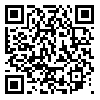Background and Aim: Several materials have been introduced for retrograde fillings, pulp capping and sealing root perforations, but their biological effect on vital tissues and cells is not clear. The purpose of this study was to evaluate the reaction of human periodontal ligament fibroblasts to four root canal filling materials: Pro Root MTA, Root MTA, Portland cement and amalgam.
Materials and Methods: In this experimental study, impacted or semi impacted third molar teeth were extracted in aseptic conditions and tissues around the roots were used to obtain fibroblast cell line. After proliferation, cells were cultured in chamber slides and extracts of materials were added to wells. Fibronectin, type I collagen and TGF- expression were measured by immunocytochemistry method. Data were analyzed by SPSS 11.0 using one way ANOVA and Tukey test. P<0.05 was considered as the limit of significance.
Results: Collagen I expression was higher in Pro Root MTA group after 24 hours (p<0.05) and in Portland cement group and positive controls after 48 hours. Portland cement group showed the highest expression of collagen after 1 week. There was no significant difference in fibronectin expression after 24 hours. After 1 week the highest expression of fibronectin was seen in Portland cement, Root MTA and Pro Root MTA groups. TGF- expression was higher in amalgam, Root MTA and Pro Root MTA specimens after 24 hours and was the highest in Pro Root MTA group after 48 hours.
Conclusion: Based on the results of this study, Portland cement and Root MTA are comparable with Pro Root MTA and better than amalgam regarding their effects on human periodontal ligament fibroblasts.
Received: 2007/05/9 | Accepted: 2008/03/17 | Published: 2013/08/20
| Rights and Permissions | |
 |
This work is licensed under a Creative Commons Attribution-NonCommercial 4.0 International License. |


